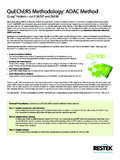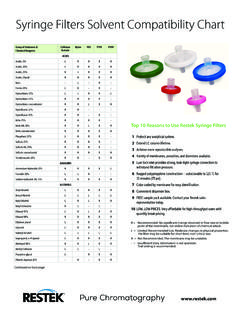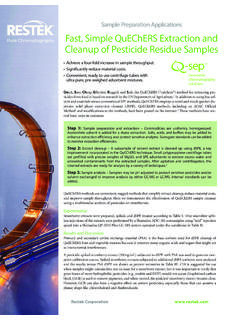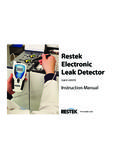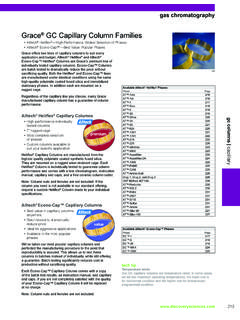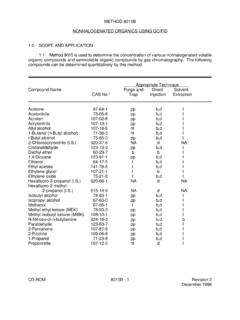Transcription of PLOT Columns Instruction Sheet - restek.com
1 PLOT Column Instruction SheetTable I: Approximate head pressures (at 40 C) usinghydrogen and Pressure for Q-, QS-, S-, and U-BONDHead Pressure for Msieve 5A and all Alumina BONDC olumn LengthInternal DiameterApprox. psiApprox. kPaApprox. psiApprox. kPa15 mm64196230 mm18124 50 mm1069149750 Instructions 1. Before removing the previously installed column from the gas chromatograph (GC), be sure to turn off the detector and cool all heated temperature zones. 2. Once all zones of the GC are cooled, turn off all gases.
2 Remove the installed column, plug each end with silicone septa (or column end caps), and return the column to its original box. 3. Remove the new PLOT column from its box. Remove the septa (or column end-caps) that are on each end of the PLOT column. Important: If your column is tied onto the metal cage with high-temperature string, do not remove the string. This high-temperature string can withstand temperatures up to 400 C. 4. Attach the appropriate GC capillary nut (fitting) onto the inlet side of the column.
3 Attach the appropriate GC column ferrule onto the inlet side of the column. See our nut and ferrule com-patibility guide for Agilent GCs. Fused silica Columns : mm Columns , use mm ID ferrule mm Columns , use mm ID ferrule mm Columns , use mm ID ferrule MXT Columns : mm and mm Columns , use mm ID ferrule mm Columns , use mm ID ferrule Note: Do not install the capillary column nut (fitting) or ferrule onto the outlet side of the column at this time; this will be performed later. Note: See Helpful Hints section for information on using particle traps.
4 5. Trim 2 cm from both ends of the column. If the fused silica column is flame sealed, remove 20 cm from both ends. Make sure that a clean, square cut is obtained. Install the inlet side of the column into the GC injection port at the appropriate distance (see your GC manual to determine the correct installation distance). 6. Turn on the carrier gas flow, using Table I to determine an appropriate head pressure. Note: A small amount of particles may exit the column when the carrier gas is first turned on.
5 This is normal as particles can become dislodged when the column is cut, when a ferrule is tightened onto a column, or due to vibrations during transport. See section C for tips on pro-tection from particles. 7. Purge the column with clean, dry carrier gas for at least 20 minutes. During this purging step, check for leaks at the injector connections using an electronic leak detector. Note that the use of carrier gas traps is also highly recommended. Important: If using hydrogen as the carrier gas, be sure to safely vent the gas exiting the col-umn and the split vent.
6 8. Set the injection port temperature according to the method, but do not exceed the maximum operating temperature for the column. Set the GC oven to 40 C. 9. Program the GC oven to heat up at 5 C/min up to the column's maximum Once the column s maximum temperature is reached, hold this temperature for at least 60 minutes for porous polymer Columns (Q-, QS-, S- and U-BOND), and for at least 2 hours for molecular sieve and alumina Columns . Do not exceed 6 hours for any Cool the GC oven.
7 Do not turn off the carrier gas. Do not remove the inlet side of the column from the injection Attach the appropriate capillary column nut (fitting) to the outlet side of the column. Attach the appropriate GC column ferrule to the outlet side of column. Trim an additional 1 cm from the outlet side of the column and verify that a clean, square cut is obtained. Before installing the column into the detector, pre-seat the ferrule onto the column using a capillary installation gauge. This will help prevent dislodged particles from entering the Install the column into the detector at the appropriate distance (see your GC manual to deter-mine the correct installation distance).
8 Confirm that your detector gases and electronics are turned on, then set the appropriate detector and injector temperatures for your analysis and allow them to stabilize. You are now ready to use the column. 2019 Restek Corporation. All rights reserved. Printed in the #600-55-001 Rev. date: 06/19 Restek patents and trademarks are the property of Restek Corporation. (See for full list.) Other trademarks in Restek literature or on its website are the property of their respective owners. Restek registered trademarks are registered in the and may also be registered in other about this or any other Restek product?
9 Contact us or your local Restek representative ( ).Helpful HintsA. Temperature Limits Never exceed the recommended maximum temperature of the column, which is given on the box label and product web page for each PLOT Column Regeneration Occasionally, alumina PLOT Columns need to be regenerated to remove moisture. To regener-ate, set the carrier gas head pressure as shown in Table I, set the GC oven temperature to the maximum column operating temperature, and condition the column for 6 hours. Occasionally, molecular sieve PLOT Columns also need to be regenerated to remove moisture.
10 To regenerate, set the carrier gas head pressure as shown in Table I, set the GC oven temperature to the maximum column temperature, and condition the column for 1 3 hours. Caution: If using hydrogen as a carrier gas, subjecting molecular sieve Columns to high tem-peratures using hydrogen carrier gas for more than an hour will cause surface activity, result-ing in carbon monoxide (CO) peak Protection from Particles PLOT Columns are not ideal for use in MS or valve systems due to their potential to generate particles that can contaminate and, in severe cases, damage GC parts.



